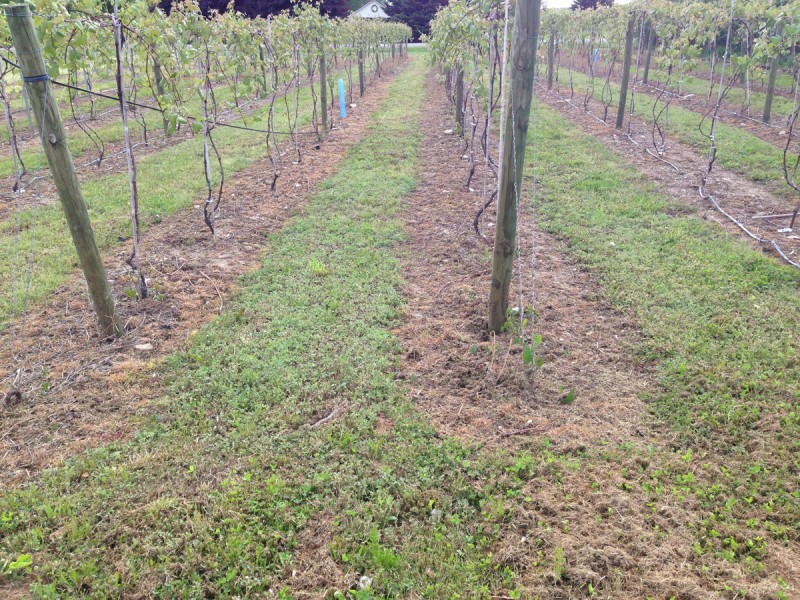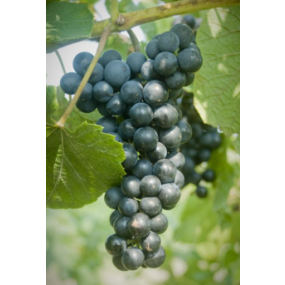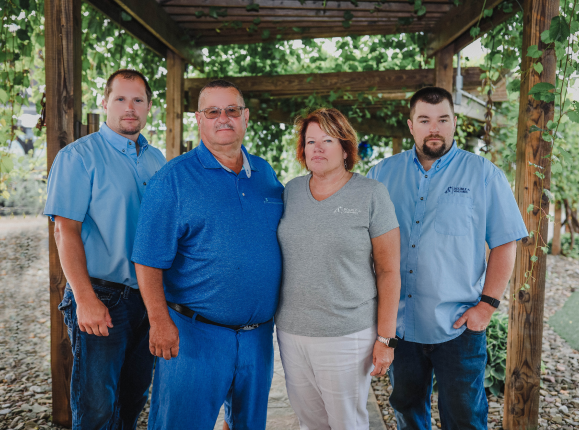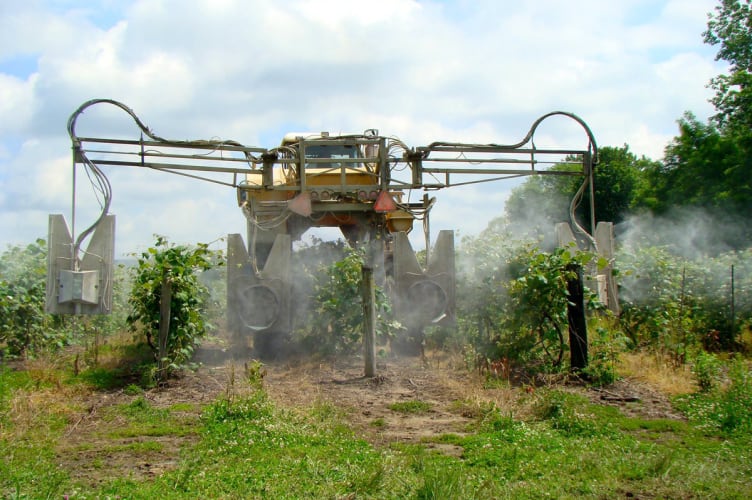Managing Weeds in Vineyards

Rick Dunst, Viticulturist, Double A Vineyards, Inc.
When trouble-shooting the cause of poor growth in vineyards (especially newly-planted ones) competition from weeds is one of the first things to consider. In my experience, new growers often underestimate the competitive effects of weeds in the vineyard. This article will summarize some of the concepts of managing weeds and cover crops as well as the tools used to accomplish good weed control in vineyards.
How Competitive are Weeds and Cover Crops in Vineyards?
During my career at Cornell University’s Vineyard Research Lab in Fredonia, NY, I had the opportunity to collaborate with several excellent researchers who helped me understand the concepts of weed competition in vineyards and how to manage it. Those researchers include the late Professor Emeritus Dr. Bob Pool and Professor Emeritus Dr. Alan Lakso from the New York State Agricultural Experiment Station in Geneva, NY, and viticulturist Alice Wise and weed scientist Dr. Andy Senesac who work at the Long Island Horticultural Research and Extension Lab in Riverhead, NY. The information presented in this article is based largely on their research studies and only skims the surface of our understanding of the topics, so I have listed a few references at the conclusion of this article for those of you who might be interested in more detail.
Research at the Fredonia Lab was primarily with own-rooted Concord, a relatively shallow-rooted grapevine. Studies showed that:
- Competition from weed or cover crop growth has a substantial effect on vine growth, and fruit yield and quality.
- Minimizing weed competition under the vines is particularly critical on newly-planted vines.
- Organic mulches can increase soil organic matter, conserve soil moisture, suppress weed growth, and lead to increased vine size. They can have a substantial effect on vine mineral nutrition and can result in higher potassium and lower magnesium status in grapevines.
- Actively growing cover crops, including legumes, between bloom and veraison can reduce vine size and fruit yield.
- Vine size and fruit yield increase proportionally to the width of the weed-free band under the vines. In one study in a mature Concord vineyard, vine growth was increased by over 300% when the entire vineyard floor was managed to exclude weed and cover crop growth, as compared with vines grown in solid sod cover, and irrigation could only minimally overcome the competitive effect of the sod.
- Mowing a competitive cover crop such as orchard grass has only a very limited and temporary effect on reducing the competitive effect of the sod.
Concord growers typically aim to grow large crops that meet processor quality standards. Conversely, premium vinifera growers often aim for low to moderate yields in order to produce high value fruit and wine. Where high vigor varieties or rootstocks are used, vine growth can often become excessive. In the arid regions of the western United States, regulated deficit irrigation practices are often used that create moderate water deficits. These deficits can lead to improved fruit quality, especially in red cultivars. Alice Wise, Cornell viticulturist on Long Island, NY, reports that several commercial growers are successfully reducing herbicide inputs by using ground covers or mowing weeds under the vines in mature vineyards. Excessive vine growth can be tamed to some extent where vine vigor is high due to variety, heavy soil, and during heavy rainy periods. In her experience, this practice can be risky on young vines, in vineyards with light sandy soil, and during extended summer droughts, especially where supplemental irrigation is not available.
Weed Management in Vineyards
It is clear that plant growth (weeds or cover crops) under the trellis can compete excessively with grapevines for water and nutrients, limiting vine growth and fruit yield. Vineyards are primarily a hillside crop, since good air drainage and movement are needed to minimize the risk of cold damage and the development of fungal diseases. On the other hand, large areas of bare soil (especially cultivated soil) are prone to soil erosion during episodes of heavy rainfall. In most commercial vineyards in the Eastern United States, a balance between excessive weed competition and minimizing the risk of erosion is struck by maintaining a relatively weed-free band underneath the vines while maintaining green cover crops in the row middles. Typically, about one-third of the vineyard soil is maintained relatively weed-free during the summer. There are several methods to accomplish this, some more practical in smaller vineyards than in larger ones:
- Synthetic mulches, such as plastic or geotextile, can be effective. Drawbacks include expense of the product and/or installation, and keeping the mulch in place when the wind is blowing and from equipment or foot traffic in the vineyard.
- Organic mulches need to be applied several inches deep in order to be effective in smothering weed growth. Concerns include expense, introduction of weed seed from the use of hay, creation of habitat favorable for rodents and cutworm, and the risk of nitrogen imbalances in the vines as the organic matter decomposes.
- Cultivating by hand as the sole means of weed control is only practical for very small vineyards. There are some effective tools for mechanical cultivation, but multiple passes are needed to maintain good weed control and it is difficult to eliminate weed growth at the base of the vines.
- Due to the limitations and expense of these practices, chemical weed control is the most common means of weed control in commercial vineyards. Pre-emergence herbicides kill weed seedlings as they germinate. Options include Tuscany, Diuron (liquid), Diuron (dry flowable), Prowl, and Surflan. Often, two pre-emergence herbicides are tank-mixed to increase the spectrum of weeds controlled. They are also often mixed with post-emergence herbicides to kill weeds that have already emerged, in addition to providing residual control. Two or more applications of post-emergence herbicides only can also provide effective weed control in vineyards, but options are limited. Glyphosate (available in 1 gallon and 2.5 gallon containers) is a systemic herbicide that (when applied at the proper time, depending on the weed species) kills the entire weed including the roots. Glyphosate also can cause damage to grapevines if grape leaves are contacted, and the risk of damage increases as the season progresses. Forfeit is a contact “burndown” herbicide that is also registered for use in grapes, and only kills contacted tissue with no risk of translocation to other parts of the vine. Specific information on the use of herbicides in vineyards can be found here, in University pest management guidelines, and on product labels.
Weed Control in Newly-Planted Vineyards
As previously mentioned, weeds can be very competitive with newly-planted vines, to the extent that vine growth and yield can be severely compromised. Herbicide options for newly-planted vineyards include Surflan and Prowl. Glyphosate and Forfeit can be used around young vines, but again, glyphosate contact with grape leaves needs to be avoided. The use of plastic grow tubes on newly-planted vines allows multiple applications of glyphosate during the first growing season by protecting the vines from herbicide contact while minimizing weed competition during establishment of the vineyard.
References:
https://flgp.cce.cornell.edu/timeline.php?id=2
https://blogs.cornell.edu/nnygrapeupdate/2014/05/14/under-trellis-management-in-vineyards-part-1/















Hi, Can you use herbicides with 2-4 D around grapevines.
2-4 D can cause devastation to your vines. It is not recommended to be use around your vines. https://doubleavineyards.com/plant-diagnostic/problems/herbicide-injury-phenoxy-herbicides/
Can Prowl H20 be applied with lifeline herbicide in early summer to stop bind wind and morning glory growth in midsummer? or would Surflan be a better pre emergent? I am in Kansas wiht clay soils. Also if you are able discuss band and row width applications as to qts per acre.